Organizational Development: Addressing Technological Problems Report
VerifiedAdded on 2020/04/01
|9
|2320
|51
Report
AI Summary
This report examines the challenges of organizational development, specifically focusing on technological problems and resistance to change within a company implementing new technology. The report identifies key issues such as employee reluctance to adopt new systems, structural rigidities, and communication breakdowns. It explores the main reasons for resistance, including employee concerns about workload, confusion, and lack of training. Furthermore, it outlines effective strategies to mitigate resistance, such as understanding employee grievances, providing training, communicating the benefits of change, and fostering leadership roles to guide the transition. The report emphasizes the importance of leadership in setting a clear vision, maintaining coordination, and resolving conflicts to ensure successful organizational development. It highlights the need for a flexible structure, effective communication, and employee engagement to drive productivity and achieve long-term organizational goals. The report concludes by underscoring the significance of organizational development in enhancing employee efficiency and overall company performance.
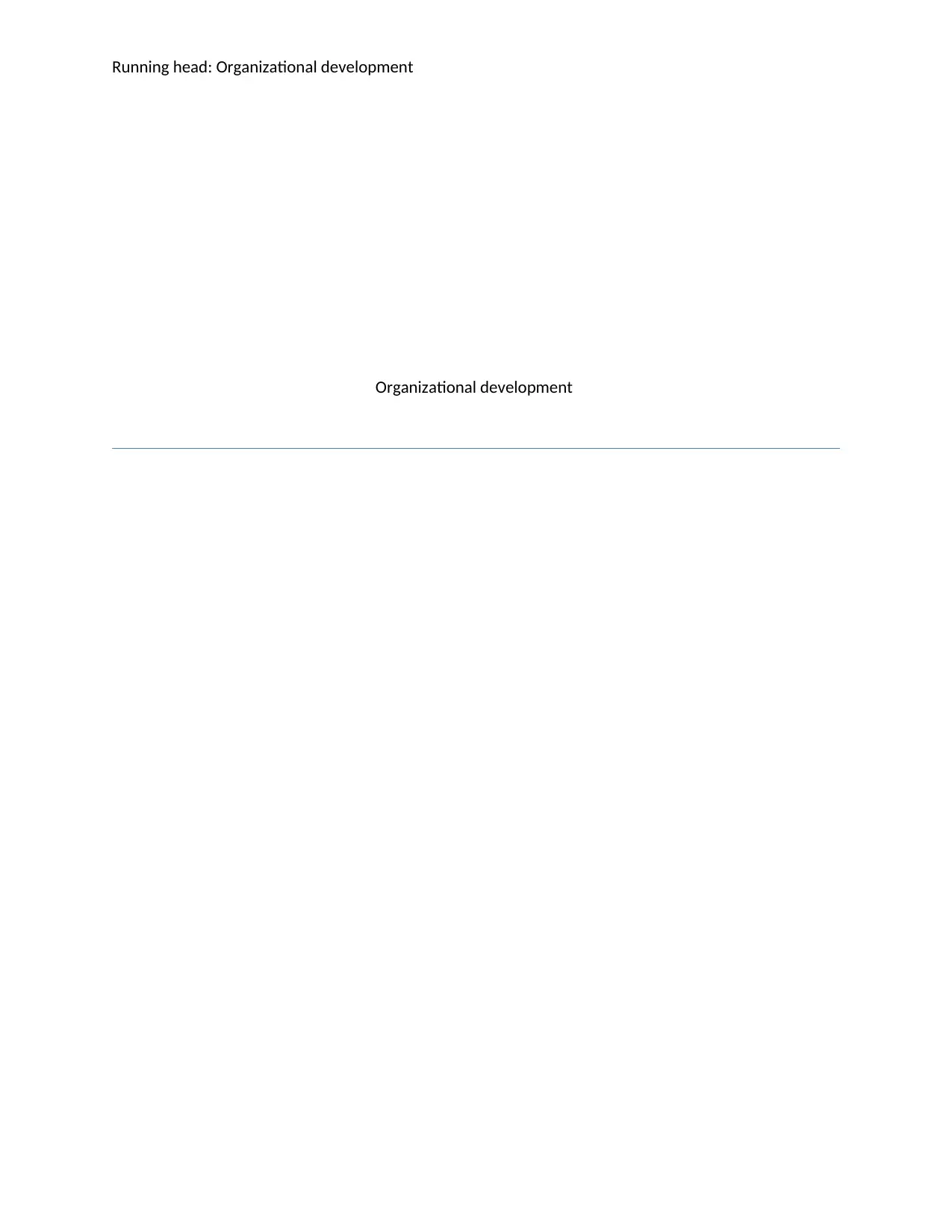
Running head: Organizational development
Organizational development
Organizational development
Paraphrase This Document
Need a fresh take? Get an instant paraphrase of this document with our AI Paraphraser
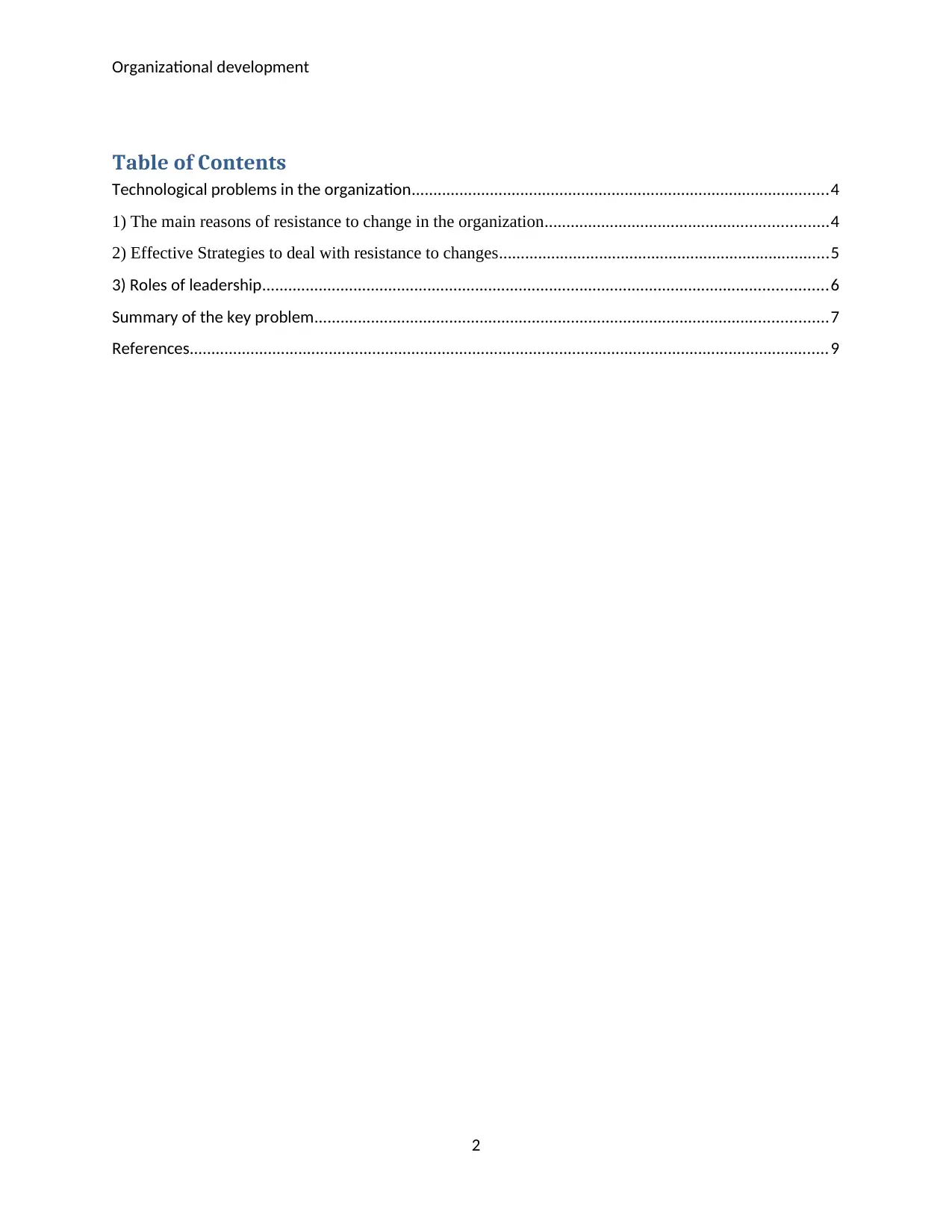
Organizational development
Table of Contents
Technological problems in the organization................................................................................................4
1) The main reasons of resistance to change in the organization.................................................................4
2) Effective Strategies to deal with resistance to changes............................................................................5
3) Roles of leadership..................................................................................................................................6
Summary of the key problem......................................................................................................................7
References...................................................................................................................................................9
2
Table of Contents
Technological problems in the organization................................................................................................4
1) The main reasons of resistance to change in the organization.................................................................4
2) Effective Strategies to deal with resistance to changes............................................................................5
3) Roles of leadership..................................................................................................................................6
Summary of the key problem......................................................................................................................7
References...................................................................................................................................................9
2
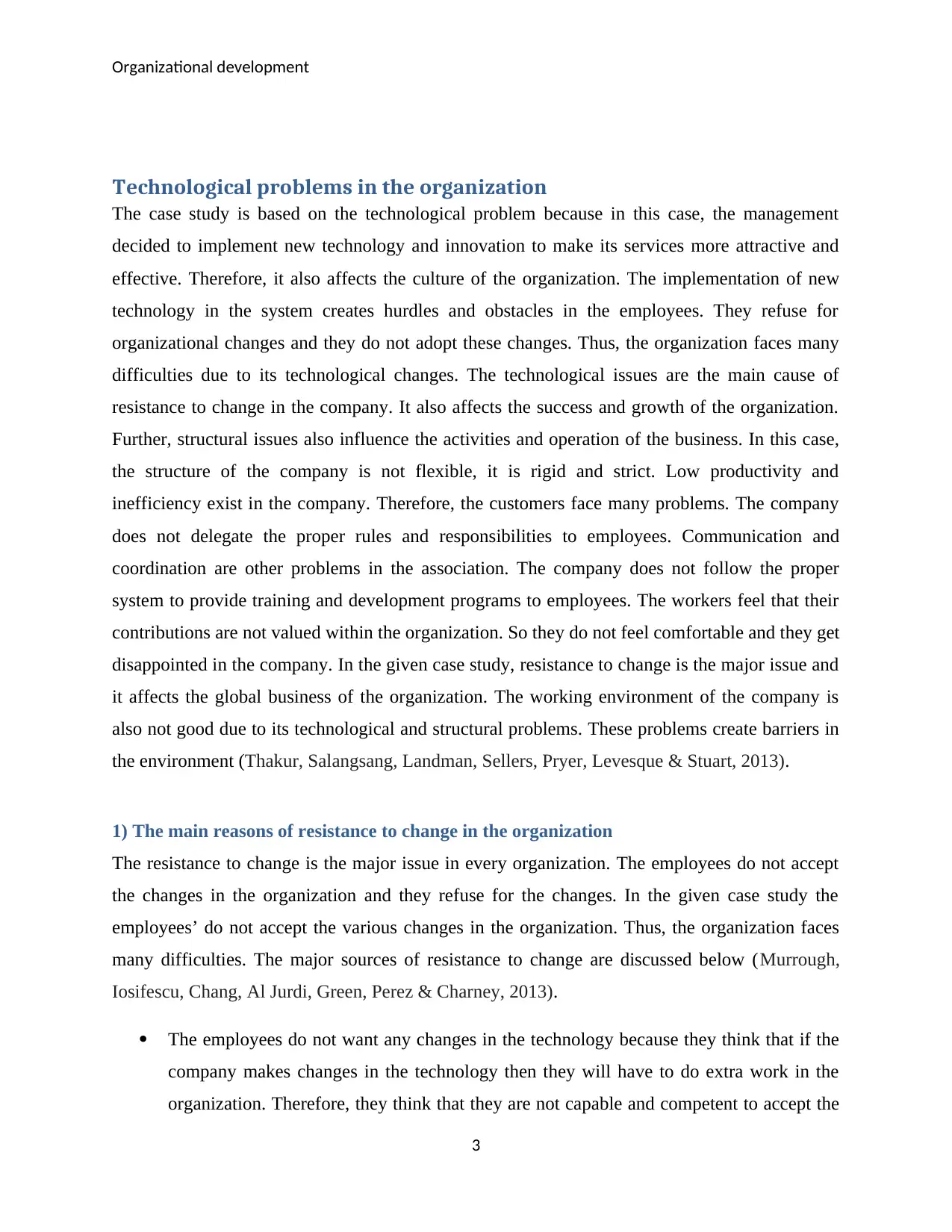
Organizational development
Technological problems in the organization
The case study is based on the technological problem because in this case, the management
decided to implement new technology and innovation to make its services more attractive and
effective. Therefore, it also affects the culture of the organization. The implementation of new
technology in the system creates hurdles and obstacles in the employees. They refuse for
organizational changes and they do not adopt these changes. Thus, the organization faces many
difficulties due to its technological changes. The technological issues are the main cause of
resistance to change in the company. It also affects the success and growth of the organization.
Further, structural issues also influence the activities and operation of the business. In this case,
the structure of the company is not flexible, it is rigid and strict. Low productivity and
inefficiency exist in the company. Therefore, the customers face many problems. The company
does not delegate the proper rules and responsibilities to employees. Communication and
coordination are other problems in the association. The company does not follow the proper
system to provide training and development programs to employees. The workers feel that their
contributions are not valued within the organization. So they do not feel comfortable and they get
disappointed in the company. In the given case study, resistance to change is the major issue and
it affects the global business of the organization. The working environment of the company is
also not good due to its technological and structural problems. These problems create barriers in
the environment (Thakur, Salangsang, Landman, Sellers, Pryer, Levesque & Stuart, 2013).
1) The main reasons of resistance to change in the organization
The resistance to change is the major issue in every organization. The employees do not accept
the changes in the organization and they refuse for the changes. In the given case study the
employees’ do not accept the various changes in the organization. Thus, the organization faces
many difficulties. The major sources of resistance to change are discussed below (Murrough,
Iosifescu, Chang, Al Jurdi, Green, Perez & Charney, 2013).
The employees do not want any changes in the technology because they think that if the
company makes changes in the technology then they will have to do extra work in the
organization. Therefore, they think that they are not capable and competent to accept the
3
Technological problems in the organization
The case study is based on the technological problem because in this case, the management
decided to implement new technology and innovation to make its services more attractive and
effective. Therefore, it also affects the culture of the organization. The implementation of new
technology in the system creates hurdles and obstacles in the employees. They refuse for
organizational changes and they do not adopt these changes. Thus, the organization faces many
difficulties due to its technological changes. The technological issues are the main cause of
resistance to change in the company. It also affects the success and growth of the organization.
Further, structural issues also influence the activities and operation of the business. In this case,
the structure of the company is not flexible, it is rigid and strict. Low productivity and
inefficiency exist in the company. Therefore, the customers face many problems. The company
does not delegate the proper rules and responsibilities to employees. Communication and
coordination are other problems in the association. The company does not follow the proper
system to provide training and development programs to employees. The workers feel that their
contributions are not valued within the organization. So they do not feel comfortable and they get
disappointed in the company. In the given case study, resistance to change is the major issue and
it affects the global business of the organization. The working environment of the company is
also not good due to its technological and structural problems. These problems create barriers in
the environment (Thakur, Salangsang, Landman, Sellers, Pryer, Levesque & Stuart, 2013).
1) The main reasons of resistance to change in the organization
The resistance to change is the major issue in every organization. The employees do not accept
the changes in the organization and they refuse for the changes. In the given case study the
employees’ do not accept the various changes in the organization. Thus, the organization faces
many difficulties. The major sources of resistance to change are discussed below (Murrough,
Iosifescu, Chang, Al Jurdi, Green, Perez & Charney, 2013).
The employees do not want any changes in the technology because they think that if the
company makes changes in the technology then they will have to do extra work in the
organization. Therefore, they think that they are not capable and competent to accept the
3
⊘ This is a preview!⊘
Do you want full access?
Subscribe today to unlock all pages.

Trusted by 1+ million students worldwide
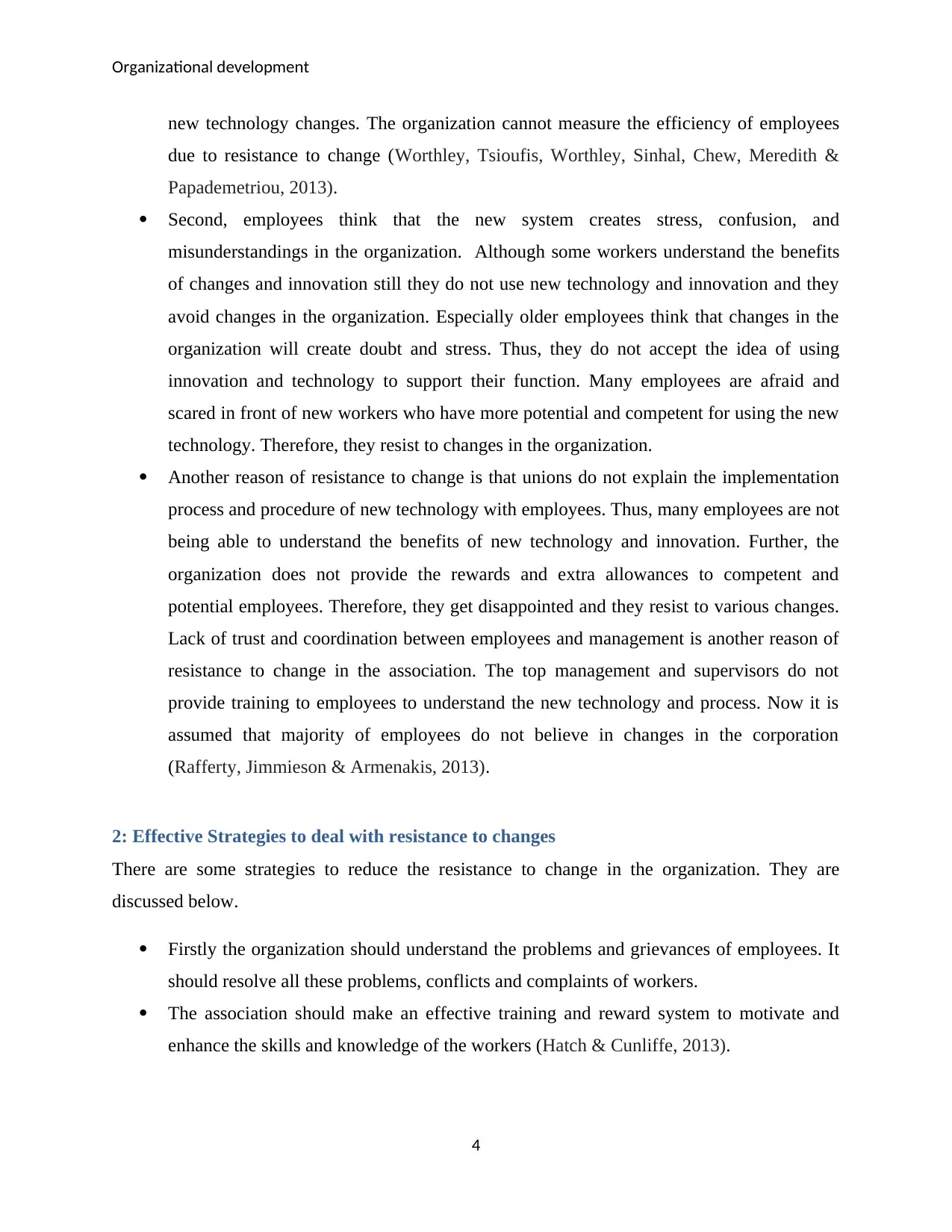
Organizational development
new technology changes. The organization cannot measure the efficiency of employees
due to resistance to change (Worthley, Tsioufis, Worthley, Sinhal, Chew, Meredith &
Papademetriou, 2013).
Second, employees think that the new system creates stress, confusion, and
misunderstandings in the organization. Although some workers understand the benefits
of changes and innovation still they do not use new technology and innovation and they
avoid changes in the organization. Especially older employees think that changes in the
organization will create doubt and stress. Thus, they do not accept the idea of using
innovation and technology to support their function. Many employees are afraid and
scared in front of new workers who have more potential and competent for using the new
technology. Therefore, they resist to changes in the organization.
Another reason of resistance to change is that unions do not explain the implementation
process and procedure of new technology with employees. Thus, many employees are not
being able to understand the benefits of new technology and innovation. Further, the
organization does not provide the rewards and extra allowances to competent and
potential employees. Therefore, they get disappointed and they resist to various changes.
Lack of trust and coordination between employees and management is another reason of
resistance to change in the association. The top management and supervisors do not
provide training to employees to understand the new technology and process. Now it is
assumed that majority of employees do not believe in changes in the corporation
(Rafferty, Jimmieson & Armenakis, 2013).
2: Effective Strategies to deal with resistance to changes
There are some strategies to reduce the resistance to change in the organization. They are
discussed below.
Firstly the organization should understand the problems and grievances of employees. It
should resolve all these problems, conflicts and complaints of workers.
The association should make an effective training and reward system to motivate and
enhance the skills and knowledge of the workers (Hatch & Cunliffe, 2013).
4
new technology changes. The organization cannot measure the efficiency of employees
due to resistance to change (Worthley, Tsioufis, Worthley, Sinhal, Chew, Meredith &
Papademetriou, 2013).
Second, employees think that the new system creates stress, confusion, and
misunderstandings in the organization. Although some workers understand the benefits
of changes and innovation still they do not use new technology and innovation and they
avoid changes in the organization. Especially older employees think that changes in the
organization will create doubt and stress. Thus, they do not accept the idea of using
innovation and technology to support their function. Many employees are afraid and
scared in front of new workers who have more potential and competent for using the new
technology. Therefore, they resist to changes in the organization.
Another reason of resistance to change is that unions do not explain the implementation
process and procedure of new technology with employees. Thus, many employees are not
being able to understand the benefits of new technology and innovation. Further, the
organization does not provide the rewards and extra allowances to competent and
potential employees. Therefore, they get disappointed and they resist to various changes.
Lack of trust and coordination between employees and management is another reason of
resistance to change in the association. The top management and supervisors do not
provide training to employees to understand the new technology and process. Now it is
assumed that majority of employees do not believe in changes in the corporation
(Rafferty, Jimmieson & Armenakis, 2013).
2: Effective Strategies to deal with resistance to changes
There are some strategies to reduce the resistance to change in the organization. They are
discussed below.
Firstly the organization should understand the problems and grievances of employees. It
should resolve all these problems, conflicts and complaints of workers.
The association should make an effective training and reward system to motivate and
enhance the skills and knowledge of the workers (Hatch & Cunliffe, 2013).
4
Paraphrase This Document
Need a fresh take? Get an instant paraphrase of this document with our AI Paraphraser
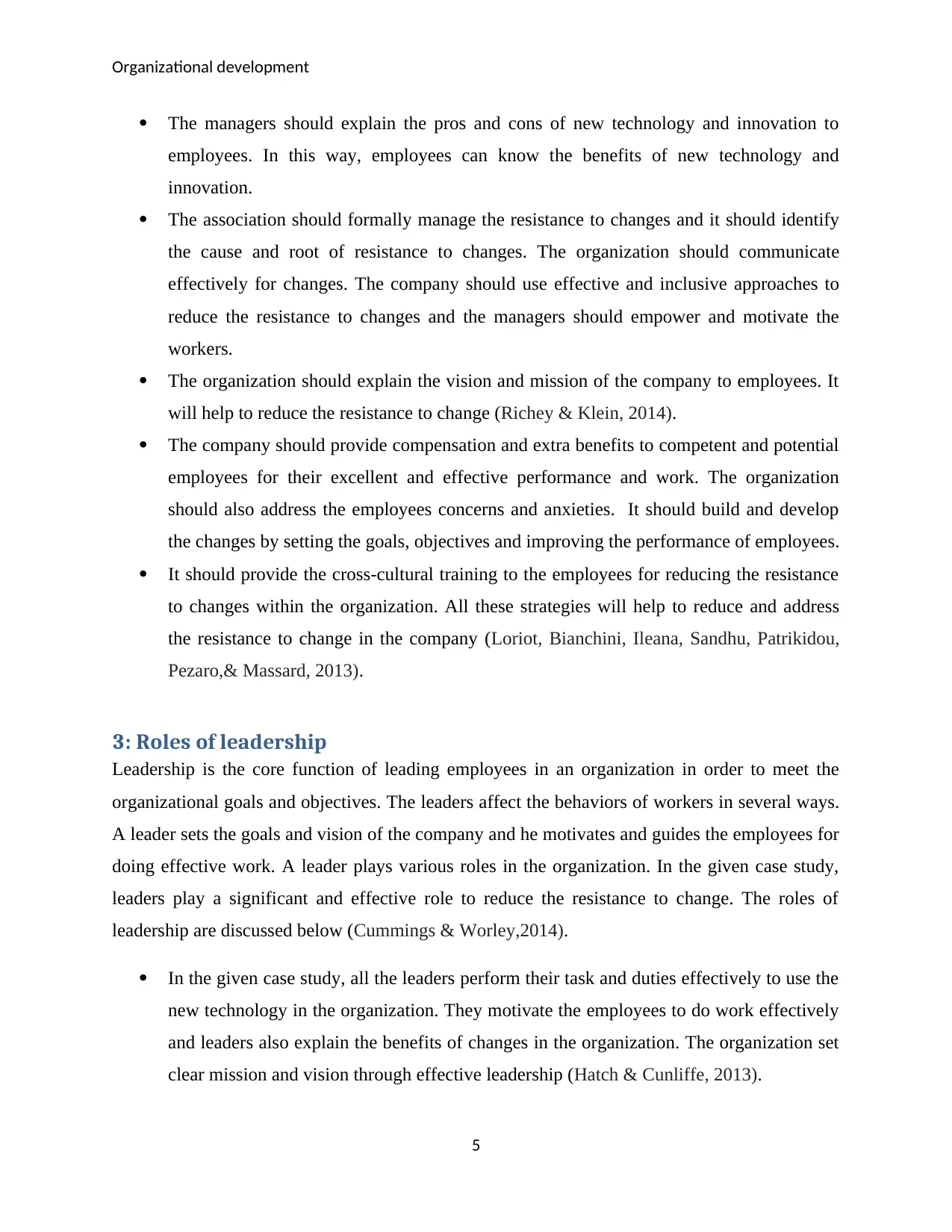
Organizational development
The managers should explain the pros and cons of new technology and innovation to
employees. In this way, employees can know the benefits of new technology and
innovation.
The association should formally manage the resistance to changes and it should identify
the cause and root of resistance to changes. The organization should communicate
effectively for changes. The company should use effective and inclusive approaches to
reduce the resistance to changes and the managers should empower and motivate the
workers.
The organization should explain the vision and mission of the company to employees. It
will help to reduce the resistance to change (Richey & Klein, 2014).
The company should provide compensation and extra benefits to competent and potential
employees for their excellent and effective performance and work. The organization
should also address the employees concerns and anxieties. It should build and develop
the changes by setting the goals, objectives and improving the performance of employees.
It should provide the cross-cultural training to the employees for reducing the resistance
to changes within the organization. All these strategies will help to reduce and address
the resistance to change in the company (Loriot, Bianchini, Ileana, Sandhu, Patrikidou,
Pezaro,& Massard, 2013).
3: Roles of leadership
Leadership is the core function of leading employees in an organization in order to meet the
organizational goals and objectives. The leaders affect the behaviors of workers in several ways.
A leader sets the goals and vision of the company and he motivates and guides the employees for
doing effective work. A leader plays various roles in the organization. In the given case study,
leaders play a significant and effective role to reduce the resistance to change. The roles of
leadership are discussed below (Cummings & Worley,2014).
In the given case study, all the leaders perform their task and duties effectively to use the
new technology in the organization. They motivate the employees to do work effectively
and leaders also explain the benefits of changes in the organization. The organization set
clear mission and vision through effective leadership (Hatch & Cunliffe, 2013).
5
The managers should explain the pros and cons of new technology and innovation to
employees. In this way, employees can know the benefits of new technology and
innovation.
The association should formally manage the resistance to changes and it should identify
the cause and root of resistance to changes. The organization should communicate
effectively for changes. The company should use effective and inclusive approaches to
reduce the resistance to changes and the managers should empower and motivate the
workers.
The organization should explain the vision and mission of the company to employees. It
will help to reduce the resistance to change (Richey & Klein, 2014).
The company should provide compensation and extra benefits to competent and potential
employees for their excellent and effective performance and work. The organization
should also address the employees concerns and anxieties. It should build and develop
the changes by setting the goals, objectives and improving the performance of employees.
It should provide the cross-cultural training to the employees for reducing the resistance
to changes within the organization. All these strategies will help to reduce and address
the resistance to change in the company (Loriot, Bianchini, Ileana, Sandhu, Patrikidou,
Pezaro,& Massard, 2013).
3: Roles of leadership
Leadership is the core function of leading employees in an organization in order to meet the
organizational goals and objectives. The leaders affect the behaviors of workers in several ways.
A leader sets the goals and vision of the company and he motivates and guides the employees for
doing effective work. A leader plays various roles in the organization. In the given case study,
leaders play a significant and effective role to reduce the resistance to change. The roles of
leadership are discussed below (Cummings & Worley,2014).
In the given case study, all the leaders perform their task and duties effectively to use the
new technology in the organization. They motivate the employees to do work effectively
and leaders also explain the benefits of changes in the organization. The organization set
clear mission and vision through effective leadership (Hatch & Cunliffe, 2013).
5
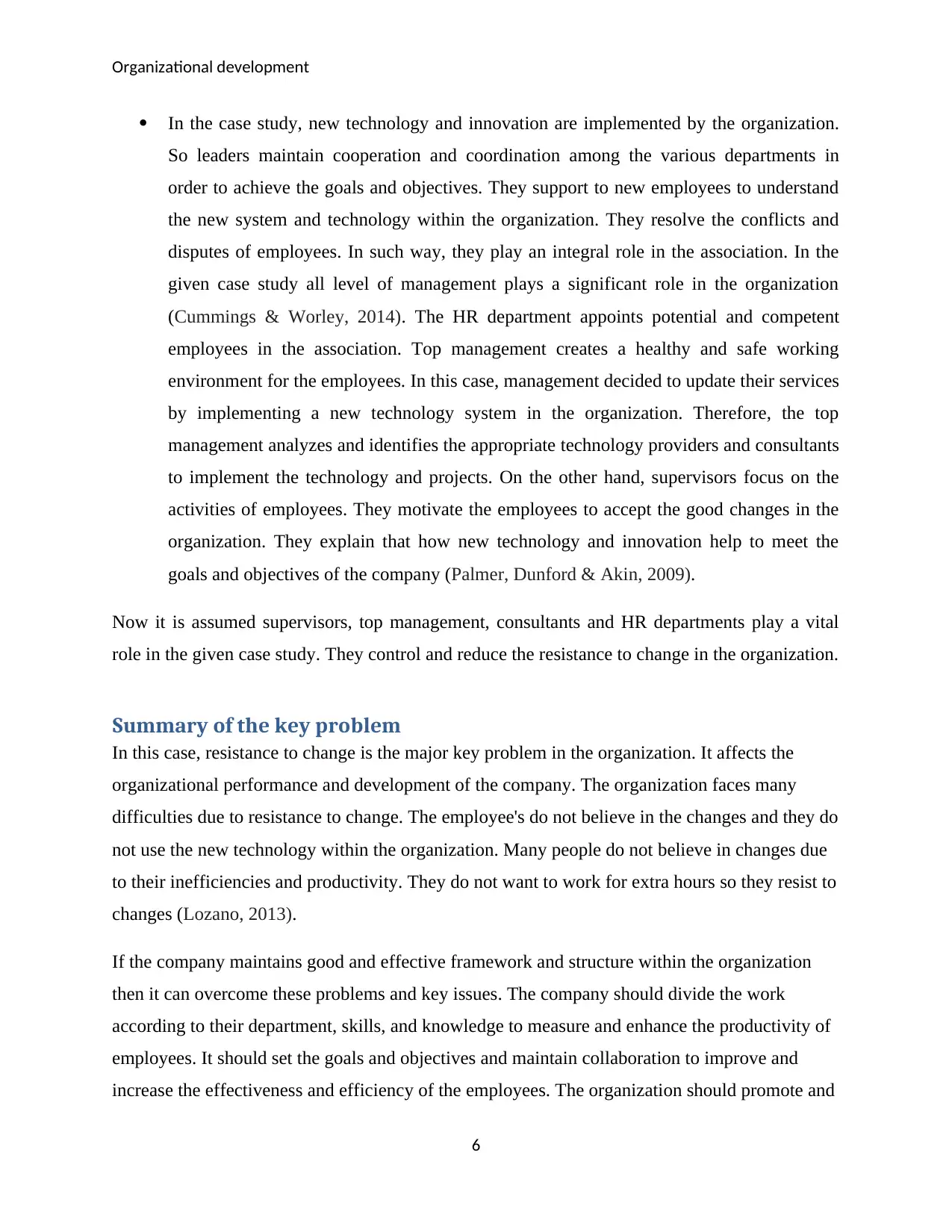
Organizational development
In the case study, new technology and innovation are implemented by the organization.
So leaders maintain cooperation and coordination among the various departments in
order to achieve the goals and objectives. They support to new employees to understand
the new system and technology within the organization. They resolve the conflicts and
disputes of employees. In such way, they play an integral role in the association. In the
given case study all level of management plays a significant role in the organization
(Cummings & Worley, 2014). The HR department appoints potential and competent
employees in the association. Top management creates a healthy and safe working
environment for the employees. In this case, management decided to update their services
by implementing a new technology system in the organization. Therefore, the top
management analyzes and identifies the appropriate technology providers and consultants
to implement the technology and projects. On the other hand, supervisors focus on the
activities of employees. They motivate the employees to accept the good changes in the
organization. They explain that how new technology and innovation help to meet the
goals and objectives of the company (Palmer, Dunford & Akin, 2009).
Now it is assumed supervisors, top management, consultants and HR departments play a vital
role in the given case study. They control and reduce the resistance to change in the organization.
Summary of the key problem
In this case, resistance to change is the major key problem in the organization. It affects the
organizational performance and development of the company. The organization faces many
difficulties due to resistance to change. The employee's do not believe in the changes and they do
not use the new technology within the organization. Many people do not believe in changes due
to their inefficiencies and productivity. They do not want to work for extra hours so they resist to
changes (Lozano, 2013).
If the company maintains good and effective framework and structure within the organization
then it can overcome these problems and key issues. The company should divide the work
according to their department, skills, and knowledge to measure and enhance the productivity of
employees. It should set the goals and objectives and maintain collaboration to improve and
increase the effectiveness and efficiency of the employees. The organization should promote and
6
In the case study, new technology and innovation are implemented by the organization.
So leaders maintain cooperation and coordination among the various departments in
order to achieve the goals and objectives. They support to new employees to understand
the new system and technology within the organization. They resolve the conflicts and
disputes of employees. In such way, they play an integral role in the association. In the
given case study all level of management plays a significant role in the organization
(Cummings & Worley, 2014). The HR department appoints potential and competent
employees in the association. Top management creates a healthy and safe working
environment for the employees. In this case, management decided to update their services
by implementing a new technology system in the organization. Therefore, the top
management analyzes and identifies the appropriate technology providers and consultants
to implement the technology and projects. On the other hand, supervisors focus on the
activities of employees. They motivate the employees to accept the good changes in the
organization. They explain that how new technology and innovation help to meet the
goals and objectives of the company (Palmer, Dunford & Akin, 2009).
Now it is assumed supervisors, top management, consultants and HR departments play a vital
role in the given case study. They control and reduce the resistance to change in the organization.
Summary of the key problem
In this case, resistance to change is the major key problem in the organization. It affects the
organizational performance and development of the company. The organization faces many
difficulties due to resistance to change. The employee's do not believe in the changes and they do
not use the new technology within the organization. Many people do not believe in changes due
to their inefficiencies and productivity. They do not want to work for extra hours so they resist to
changes (Lozano, 2013).
If the company maintains good and effective framework and structure within the organization
then it can overcome these problems and key issues. The company should divide the work
according to their department, skills, and knowledge to measure and enhance the productivity of
employees. It should set the goals and objectives and maintain collaboration to improve and
increase the effectiveness and efficiency of the employees. The organization should promote and
6
⊘ This is a preview!⊘
Do you want full access?
Subscribe today to unlock all pages.

Trusted by 1+ million students worldwide
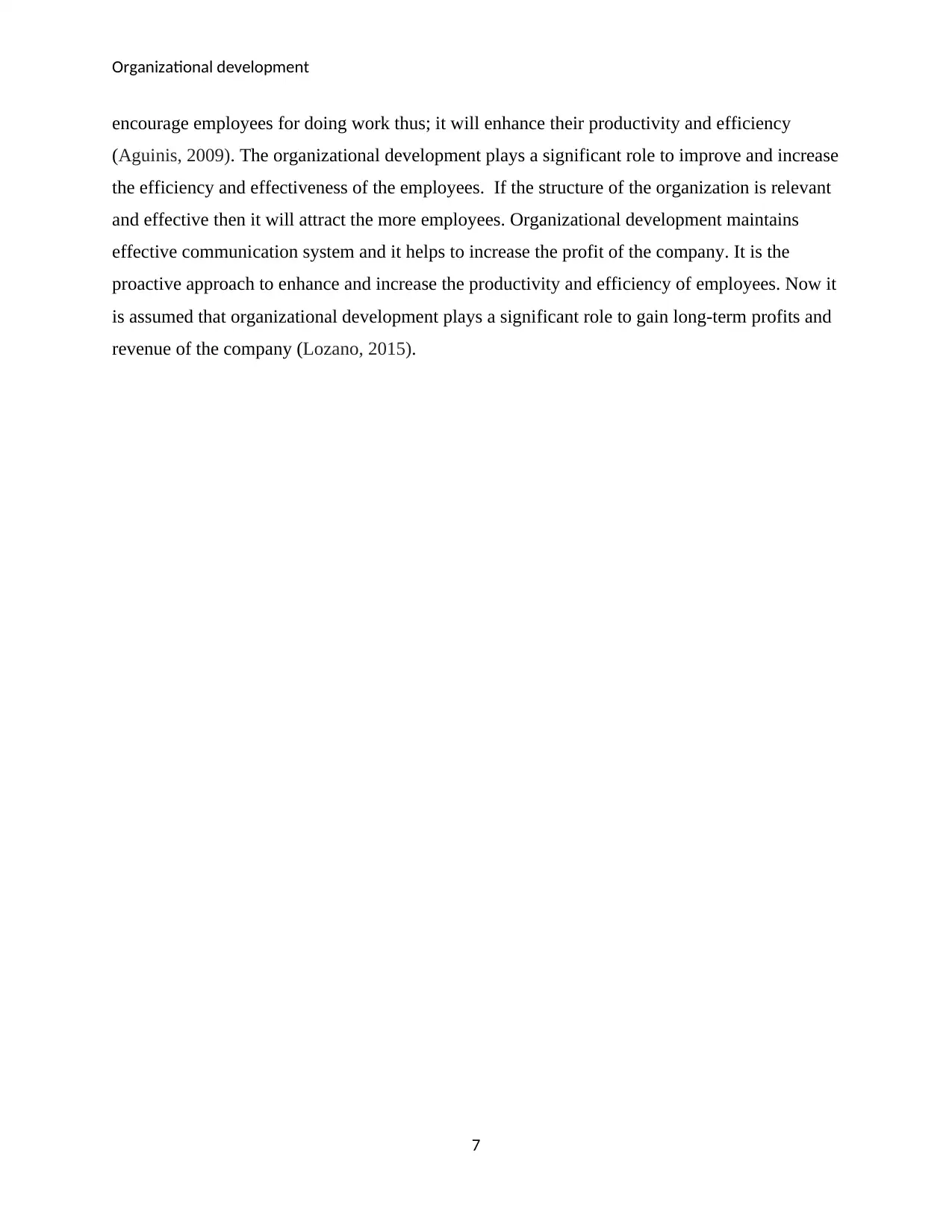
Organizational development
encourage employees for doing work thus; it will enhance their productivity and efficiency
(Aguinis, 2009). The organizational development plays a significant role to improve and increase
the efficiency and effectiveness of the employees. If the structure of the organization is relevant
and effective then it will attract the more employees. Organizational development maintains
effective communication system and it helps to increase the profit of the company. It is the
proactive approach to enhance and increase the productivity and efficiency of employees. Now it
is assumed that organizational development plays a significant role to gain long-term profits and
revenue of the company (Lozano, 2015).
7
encourage employees for doing work thus; it will enhance their productivity and efficiency
(Aguinis, 2009). The organizational development plays a significant role to improve and increase
the efficiency and effectiveness of the employees. If the structure of the organization is relevant
and effective then it will attract the more employees. Organizational development maintains
effective communication system and it helps to increase the profit of the company. It is the
proactive approach to enhance and increase the productivity and efficiency of employees. Now it
is assumed that organizational development plays a significant role to gain long-term profits and
revenue of the company (Lozano, 2015).
7
Paraphrase This Document
Need a fresh take? Get an instant paraphrase of this document with our AI Paraphraser
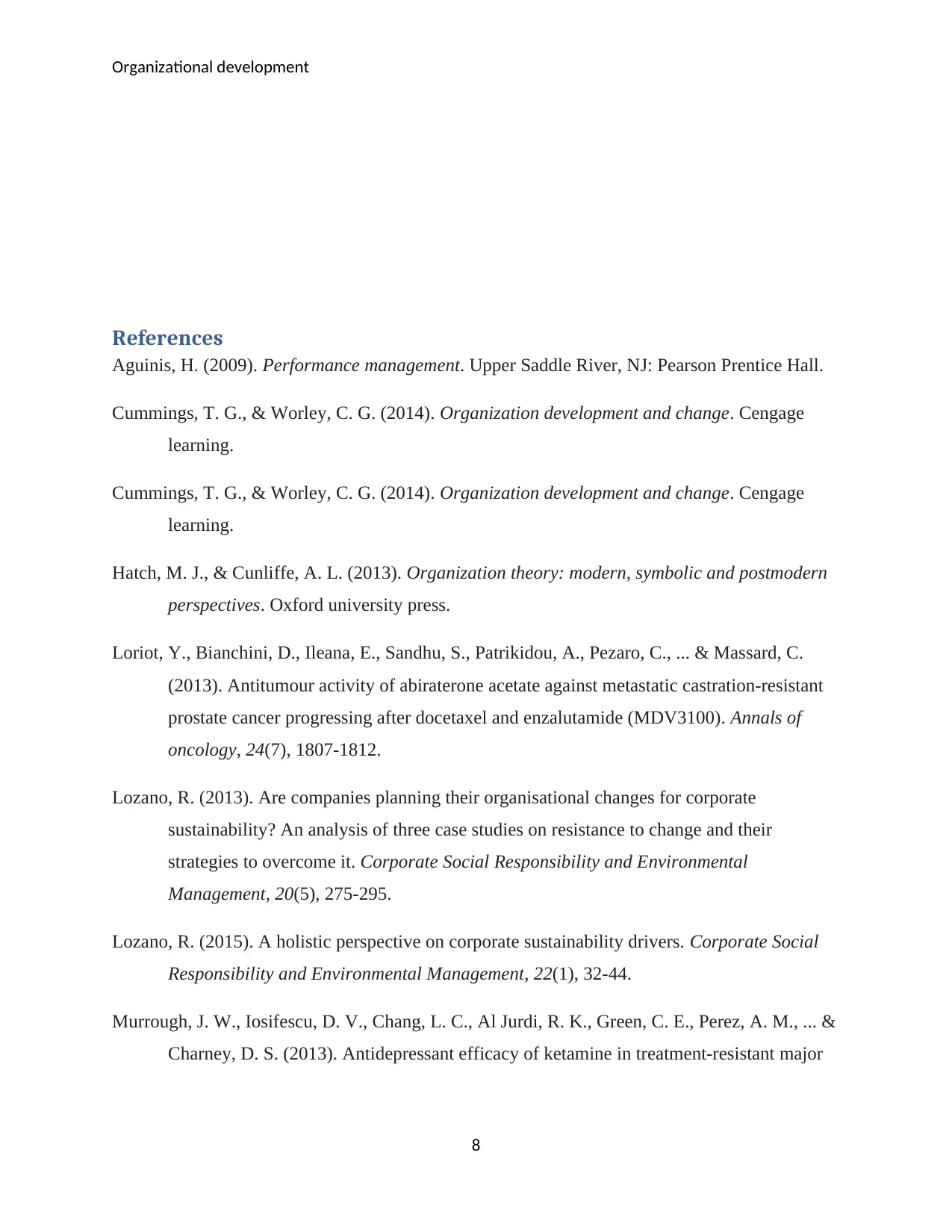
Organizational development
References
Aguinis, H. (2009). Performance management. Upper Saddle River, NJ: Pearson Prentice Hall.
Cummings, T. G., & Worley, C. G. (2014). Organization development and change. Cengage
learning.
Cummings, T. G., & Worley, C. G. (2014). Organization development and change. Cengage
learning.
Hatch, M. J., & Cunliffe, A. L. (2013). Organization theory: modern, symbolic and postmodern
perspectives. Oxford university press.
Loriot, Y., Bianchini, D., Ileana, E., Sandhu, S., Patrikidou, A., Pezaro, C., ... & Massard, C.
(2013). Antitumour activity of abiraterone acetate against metastatic castration-resistant
prostate cancer progressing after docetaxel and enzalutamide (MDV3100). Annals of
oncology, 24(7), 1807-1812.
Lozano, R. (2013). Are companies planning their organisational changes for corporate
sustainability? An analysis of three case studies on resistance to change and their
strategies to overcome it. Corporate Social Responsibility and Environmental
Management, 20(5), 275-295.
Lozano, R. (2015). A holistic perspective on corporate sustainability drivers. Corporate Social
Responsibility and Environmental Management, 22(1), 32-44.
Murrough, J. W., Iosifescu, D. V., Chang, L. C., Al Jurdi, R. K., Green, C. E., Perez, A. M., ... &
Charney, D. S. (2013). Antidepressant efficacy of ketamine in treatment-resistant major
8
References
Aguinis, H. (2009). Performance management. Upper Saddle River, NJ: Pearson Prentice Hall.
Cummings, T. G., & Worley, C. G. (2014). Organization development and change. Cengage
learning.
Cummings, T. G., & Worley, C. G. (2014). Organization development and change. Cengage
learning.
Hatch, M. J., & Cunliffe, A. L. (2013). Organization theory: modern, symbolic and postmodern
perspectives. Oxford university press.
Loriot, Y., Bianchini, D., Ileana, E., Sandhu, S., Patrikidou, A., Pezaro, C., ... & Massard, C.
(2013). Antitumour activity of abiraterone acetate against metastatic castration-resistant
prostate cancer progressing after docetaxel and enzalutamide (MDV3100). Annals of
oncology, 24(7), 1807-1812.
Lozano, R. (2013). Are companies planning their organisational changes for corporate
sustainability? An analysis of three case studies on resistance to change and their
strategies to overcome it. Corporate Social Responsibility and Environmental
Management, 20(5), 275-295.
Lozano, R. (2015). A holistic perspective on corporate sustainability drivers. Corporate Social
Responsibility and Environmental Management, 22(1), 32-44.
Murrough, J. W., Iosifescu, D. V., Chang, L. C., Al Jurdi, R. K., Green, C. E., Perez, A. M., ... &
Charney, D. S. (2013). Antidepressant efficacy of ketamine in treatment-resistant major
8
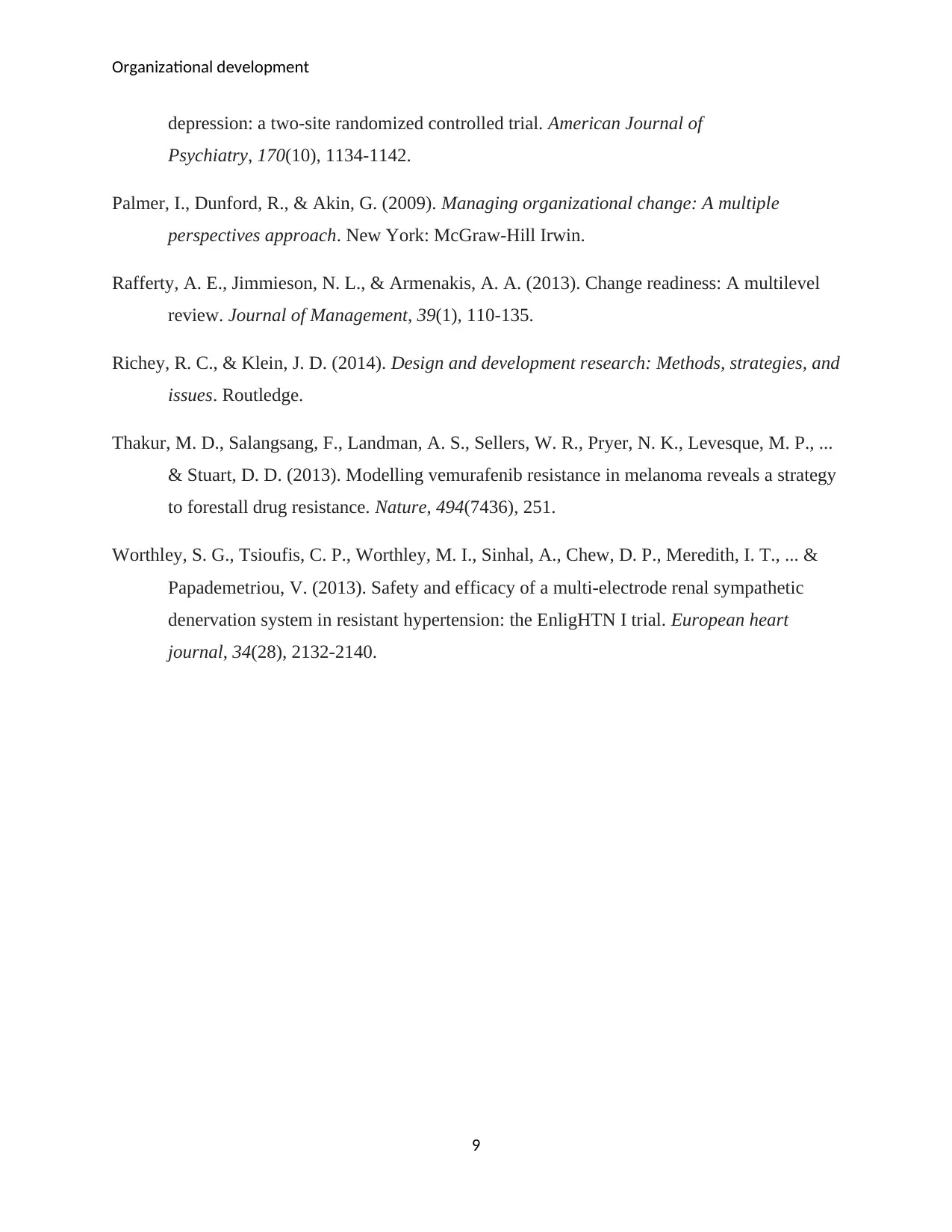
Organizational development
depression: a two-site randomized controlled trial. American Journal of
Psychiatry, 170(10), 1134-1142.
Palmer, I., Dunford, R., & Akin, G. (2009). Managing organizational change: A multiple
perspectives approach. New York: McGraw-Hill Irwin.
Rafferty, A. E., Jimmieson, N. L., & Armenakis, A. A. (2013). Change readiness: A multilevel
review. Journal of Management, 39(1), 110-135.
Richey, R. C., & Klein, J. D. (2014). Design and development research: Methods, strategies, and
issues. Routledge.
Thakur, M. D., Salangsang, F., Landman, A. S., Sellers, W. R., Pryer, N. K., Levesque, M. P., ...
& Stuart, D. D. (2013). Modelling vemurafenib resistance in melanoma reveals a strategy
to forestall drug resistance. Nature, 494(7436), 251.
Worthley, S. G., Tsioufis, C. P., Worthley, M. I., Sinhal, A., Chew, D. P., Meredith, I. T., ... &
Papademetriou, V. (2013). Safety and efficacy of a multi-electrode renal sympathetic
denervation system in resistant hypertension: the EnligHTN I trial. European heart
journal, 34(28), 2132-2140.
9
depression: a two-site randomized controlled trial. American Journal of
Psychiatry, 170(10), 1134-1142.
Palmer, I., Dunford, R., & Akin, G. (2009). Managing organizational change: A multiple
perspectives approach. New York: McGraw-Hill Irwin.
Rafferty, A. E., Jimmieson, N. L., & Armenakis, A. A. (2013). Change readiness: A multilevel
review. Journal of Management, 39(1), 110-135.
Richey, R. C., & Klein, J. D. (2014). Design and development research: Methods, strategies, and
issues. Routledge.
Thakur, M. D., Salangsang, F., Landman, A. S., Sellers, W. R., Pryer, N. K., Levesque, M. P., ...
& Stuart, D. D. (2013). Modelling vemurafenib resistance in melanoma reveals a strategy
to forestall drug resistance. Nature, 494(7436), 251.
Worthley, S. G., Tsioufis, C. P., Worthley, M. I., Sinhal, A., Chew, D. P., Meredith, I. T., ... &
Papademetriou, V. (2013). Safety and efficacy of a multi-electrode renal sympathetic
denervation system in resistant hypertension: the EnligHTN I trial. European heart
journal, 34(28), 2132-2140.
9
⊘ This is a preview!⊘
Do you want full access?
Subscribe today to unlock all pages.

Trusted by 1+ million students worldwide
1 out of 9
Related Documents
Your All-in-One AI-Powered Toolkit for Academic Success.
+13062052269
info@desklib.com
Available 24*7 on WhatsApp / Email
![[object Object]](/_next/static/media/star-bottom.7253800d.svg)
Unlock your academic potential
Copyright © 2020–2025 A2Z Services. All Rights Reserved. Developed and managed by ZUCOL.





